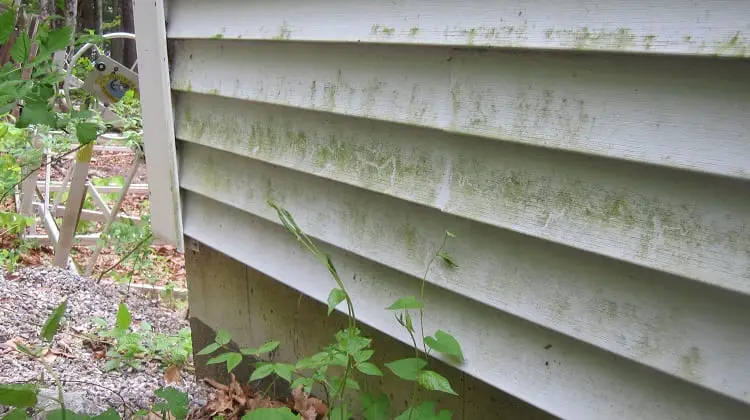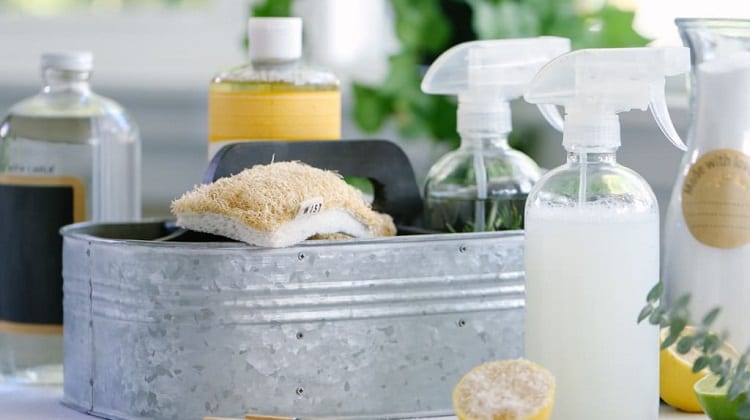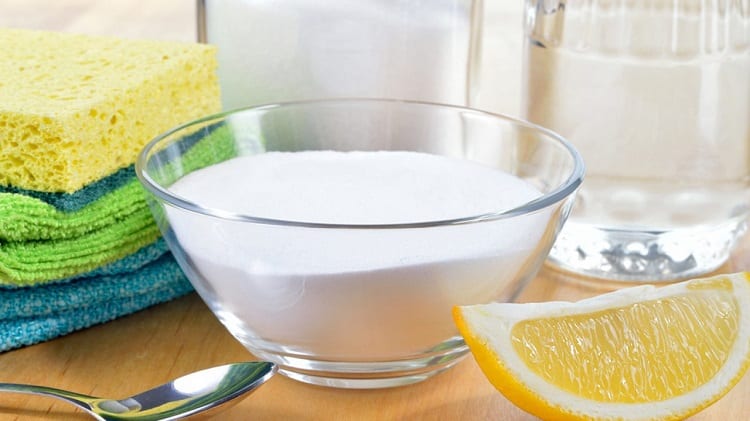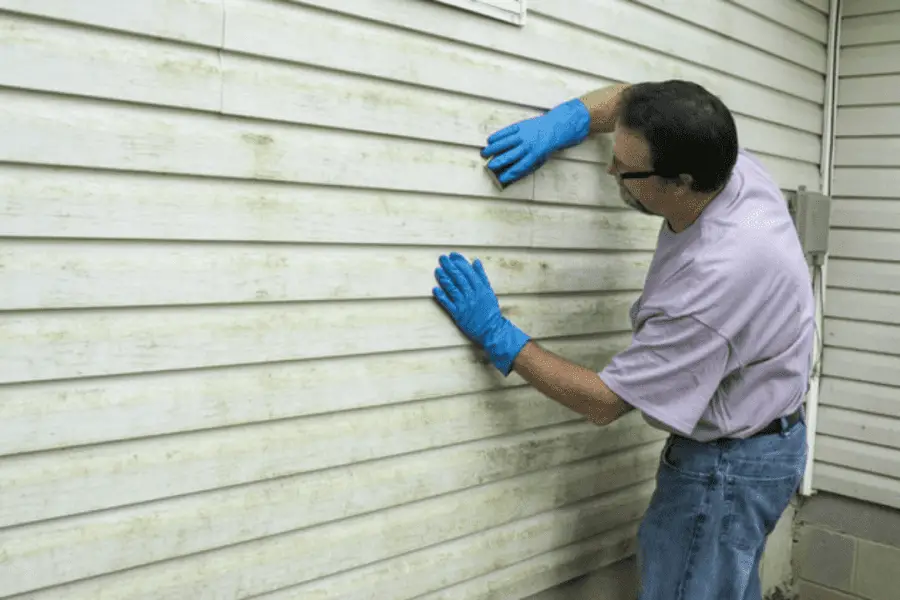Vinyl siding is a versatile, durable and quite resilient building material, however, it does require regular cleaning and care.
Since it is an exterior product, it can accumulate a host of dirt and grime due to things such as bird and insect droppings, pollen, spiderwebs, and rust as well.
In moist and shady areas, mold and mildew can grow and is also vulnerable to the discoloring effects from herbicides, pesticides, and fertilizers.
The finishing may also be tainted by a number of commonly used household products such as driveway sealant, tar, caulking and motor oil, and paint.
However, cleaning vinyl siding and getting rid of mold and mildew is fairly easy to do. There’s a wide variety of cleaning products on the market to help achieve this and also remove typical stains.
In the following article, we’ll take a closer look at some of the easiest ways to clean vinyl siding.
Table of Contents
Causes of Mold Growth on Vinyl Siding

Vinyl siding is a very popular material used in the exterior of homes. This is mainly because it’s both durable and affordable.
However, the disadvantage is that mold tends to grow on it easily. Irrespective of whether you are considering adding vinyl siding to your home or you are concerned about the existing siding you have, it’s always good to find out how mold and can affect the siding.
Also learning about how to get rid of the issue once you are faced with it is crucial. Some of the reasons that mold accumulates on your siding include the buildup of dirt.
Once dirt accumulates on the surface, and it is not cleaned for quite a while, it leads to mold and mildew growth because these fungi need dirt – in order to thrive. If your home is near trees, then mold could end up on the siding due to sugar sap falling from the trees, and that makes it quite an appealing environment for fungi.
Another cause is excess moisture. If there is excess moisture beneath the surface of the vinyl siding, or water gets trapped behind the siding or even within it, or there’s a broken drain pipe or gutter constantly dripping onto the siding, this will keep it wet all the time. Ultimately, it will lead to the buildup of mold and mildew.
Dirt is not the only culprit leading to the growth of mold. Mold and other fungi love being in the shade. So if your house is constantly shaded, it’s more likely to develop a mold problem. Some of the things blocking the sunlight could be a porch roof or tree, and this keeps the siding from receiving sunlight.
Ultimately, unless you have some way of getting direct sunlight onto the siding, you need to keep them extra clean all the time.
How to Prevent Mold Growth on Vinyl Siding

Lack of sunlight, moisture, dirt and grime are common causes that lead to the growth of mold and mildew. So it makes sense that after eliminating these issues, mold will eventually find your siding less appealing.
However, it’s not always that simple. It can be quite a challenge to keep your house from getting wet or dirty and also removing trees and shade structures isn’t always desirable. However, there are other ways to keep mold and mildew from appearing.
Cleaning siding with a disinfectant or detergent is one way of preventing the buildup of mold. There are products that are specifically made to tackle the growth of fungi on vinyl siding.
One of the best remedies for mold is using a solution of vinegar and water to safely eradicate mold on your siding.
You may also use a pressure washer, however, not all siding manufacturers will recommend pressure washing. So if you do decide to use a pressure washer, you may void the warranty. So check with the company first before deciding to do so.
Even if you do decide to use a pressure washer, ensure that it’s not set at maximum pressure. It’s also a good idea to prepare the siding first before using the pressure washer by scrubbing and disinfecting it.
Bleach has always been the go-to solution because chlorine kills mold on contact. So you don’t need a strong solution, and the recommended portion is one part bleach to 10 parts water or about half a cup of bleach in a gallon of water. Ultimately, you can use this mixture as well as a soft scrubbing brush to clean your siding.
You may also choose to scrub the siding. A stiff bristle brush or natural fiber scrub brush is recommended. You should avoid metal fiber brushes as they could damage your siding and don’t push too hard against the flexible vinyl as you could break it.
You can also attach a long pole to the end of the scrub – to avoid climbing up the ladder in order to reach under the eaves.
Pressure washing is always more effective if you do it while the mold is still wet from scrubbing. Start at the top and work your way down. After you have washed the wall, examine the siding and if you still find traces of mold, then repeat the process.
Environmentally Friendly Cleaner for Vinyl Mold Removal

If you’re looking for an environmentally friendly cleaning product to help you clean your siding, then you can simply make one at home. A simple blend of common cleaning products will help eliminate mold and mildew from your home.
You need to start off with a 5 gallon bucket half-filled with warm water. Thereafter, add 1 gallon of liquid bleach. Keep stirring the bleach into the water and add 2 cups of trisodium phosphate.
You will usually find this at your local hardware or pool store in the paint section. Mix all the ingredients in the water and while still stirring, add one cup of borax.
Combine this mixture well and lastly add a quarter cup of liquid dishwashing soap and full the rest of the bucket with water. If you need more soap, then you can gradually add more until you receive the desired effect. So this mixture makes 5 gallons of an exterior house wash.
If you’re looking for a mixer that’s even more simple and environmentally friendly, then you can try this one. All of these ingredients are natural products that are found in your cupboard right now.
You will need baking soda, vinegar, warm water, and a container to make this mixture. Start by adding 2 cups of warm water to the container, thereafter add a cup of vinegar and sprinkle a tablespoon of baking soda into the container.
You should take care to add the ingredients a little bit at a time to keep it from completely foaming up. Once you combine all of these ingredients, you can use it to clean your vinyl siding safely, yet effectively.
Can You Use Dawn for Vinyl Siding

If you’re wondering whether you can use Dawn dishwashing soap to clean vinyl siding, then the short answer is, yes you can.
It is just as effective as any other household detergent, and if you would like to make it more effective, you can add a tiny bit of bleach in it or perhaps use the detergent inside your pressure washer.
Recommended Tools Needed to Clean Mold Vinyl Siding
Cleaning vinyl siding is much the same as cleaning mold off any other surfaces.
However, your cleaning tools may need to be a little more abrasive since sidings are exterior structures, and you may need to apply a bit more pressure as well. Some of the tools that will be required are:
- Water hose
- Pressure hose
- Goggles
- Gloves
- Towels
- Sponges
- Ladder
- Stiff bristled scrubbing brush
- Long handle to attach to the scrubbing brush
- Detergents
Homemade Vinyl Mold Removers

Although vinyl siding is intended to be a low-maintenance exterior house cleaner, it’s not maintenance-free. It gets static and grimy and grows mold on any other surface that is exposed to moisture. However, it is simple and easy to keep your vinyl siding clean and shiny.
There are quite a few good cleaning solutions to use and will resolve some of the most common problems you will ever encounter with siding.
Store-bought cleaning solutions are not always environmentally friendly and can cause harm to plants if they fall on them. It’s important to use plastic where possible to cover plants and keep them from getting damaged.
Some of the best ways to clean your vinyl siding are to use natural ingredients such as vinegar and baking soda. A solution of vinegar and baking soda is ideal for cleaning the siding on the outside of your home, and you may even use it to clean your interior vinyl floors.
You can then take this homemade cleaning solution and add it to the pressure washer for an even more potent effect. You can also apply it onto stubborn stains and allow it to sit for a minute or two before rinsing it off.
Another simple recipe is adding three-quarter cups of trisodium phosphate, a third of a cup of powdered laundry detergent and 1 gallon of water. Hot water works best, especially when using a bucket and a brush; however, cold water works too.
What are the Best Nature Friendly Cleaners for Vinyl Siding
When it comes to cleaning siding, you can either choose to go with chemical or store-bought detergents or choose to make your own cleaning detergents with ingredients you already have and use at home.
However, if you have plants near the vinyl siding and you don’t want to kill them, then using natural ingredients is highly recommended.
Nature-friendly products will also help lessen your carbon footprint on the earth and do your part in keeping the balance in nature.
Some of the best nature-friendly cleaners for vinyl are homemade. Your own homemade mixtures may include vinegar, baking soda, lemon juice and other natural ingredients that are all completely safe on the environment, yet effective for eliminating mold from your siding.
Types of Mold Found on Exterior of Home
There are different types of mold that can be found on the exterior of the home. Some of these molds that survive outdoors may also thrive indoors. While some types of molds are allergenic, others are pathogenic and you get certain species that are toxic.
One of the most toxic types of mold found indoors and outdoors is called Aspergillus. This mold commonly leads to health problems such as aggravating asthma symptoms and respiratory problems.
So while this mold is extremely unhealthy and bad, the best thing to do would be to eliminate it as soon as possible if you come across it either indoors or outdoors.
Recourses:

